This guide initially displays common reptiles and amphibians of all shapes. Use the selectors below to view particular shapes, include rare species, or search by name.
Reptiles are a group of vertebrate animals that are cold-blooded, i.e., they regulate their inner body temperature by responding to the temperature of their environment, basking in the sun to warm themselves up or lying in the shade to cool off. Animals in the class Reptilia include snakes, lizards, crocodiles, turtles and tortoises. All of these creatures are covered in scales and breathe air through their lungs throughout their lifetime. In addition, they all produce eggs. Most reptiles lay eggs from which young hatch directly after an incubation period. However, some snakes, including rattlesnakes, carry their eggs internally and then give birth to live young.
Like reptiles, amphibians (frogs, toads, newts, salamanders and worm-like caecilians) are cold-blooded vertebrates. However, unlike reptiles, animals in the class Amphibia do not have scales but rather have skin that is permeable so that molecules and gases can pass through it. In addition, they lay their eggs in water where the young are born as larvae using gills to breath. The larvae grow and change into the adult form. This process includes developing lungs thus allowing the adults to live on land. Amphibians are considered to be the link between fish and reptiles as they were the first animals to leave the water and come onto land.
The question often arises of how to tell the difference between a frog and a toad. Although they are closely related amphibians, there are some features that can be used to distinguish them. Frogs have long hind legs for jumping, moist and usually smooth skin and bulging eyes. In addition, they typically stay in water. Toads have short legs for walking and hopping, dry and bumpy skin and do not have bulging eyes but do have poison glands behind their eyes. They mostly stay on land.
This guide describes the modest number of amphibians and reptiles including two venomous snakes that can be found in Los Alamos and the surrounding areas. An excellent reference for more information is Amphibians and Reptiles of Los Alamos County by Teralene S. Foxx, Timothy K. Haarmann, and David C Keller.
Reptile and Amphibian References
Amphibiaweb
Amphibians and Reptiles of Los Alamos County [PDF]
Bartlett, R.D., Bartlett, P.P., 2013 New Mexico’s Reptiles and Amphibians: A Field Guide. University of NM Press
Biota Information System of New Mexico
Degenhardt, W.G., Painter, C.W., Price, A.H., 2005 Amphibians and Reptiles of New Mexico. University of NM Press
eNature
Encyclopedia of Life
New Mexico Herpetological Society
The Reptile Database
Subject Area Experts (all guides)
Steve Cary (butterflies)
Beth Cortright (insects)
Terry Foxx (invasive plants)
Leslie Hansen (mammals)
Richard Hansen (fish, mammals)
Dorothy Hoard (butterflies, trees)
Chick Keller (flowers, herbarium)
Shari Kelley (geology)
Kirt Kempter (geology)
Garth Tietjen (reptiles)
David Yeamans (birds)
Web Development and Content Management
Pat Bacha
Jennifer Macke
Graham Mark
Akkana Peck
Contact
Please contact us for local nature questions and sightings. We welcome comments, corrections, and additions to our guides.
For more information about local nature, please visit our Nature Blog or subscribe to PEEC This Week.
Make Selection
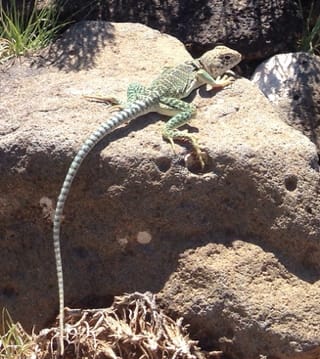 Photo: male by alikat 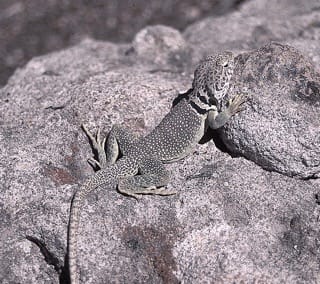 Photo: female by Sally King |  Eastern Collared Lizard(Crotaphytus collaris)Family: Crotaphytidae (Leopard Lizards) Size: 8 - 14 in (20 - 36 cm) Status: native; uncommon Habitat: arid areas with large rocks and hilly regions with limestone ledges Typical location: Pajarito Plateau, White Rock Canyon Large lizard with a dark stripe near the throat is most commonly found from late April to May. They like boulder-strewn or talus slopes where they bask and prey on insects and other lizards. They are mainly insectivorous. When startled they will run with forelegs lifted off the ground and the tail raised. Tracks Info Photos Distribution |
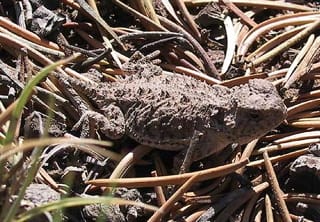 Photo: juvenile by Jennifer Macke 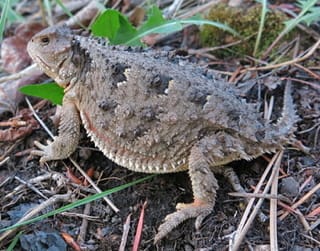 Photo: adult by Beth Cortright |  Hernandez's Short-horned Lizard, Greater Short-horned Lizard, Mountain Short-horned Lizard(Phrynosoma hernandesi hernandesi)Family: Phrynosomatidae (North American Spiny Lizards) Size: 2.5 - 5.9 in (6 - 15 cm) Status: native; locally common Habitat: open rocky or sandy plains; forested areas up to 9,000 ft (2,700 m) Typical location: Deer Trap Mesa, White Rock, Kwage Mesa This squat little lizard has an oval shaped body and dagger-like head spines. As this lizard scurries away in a waddling movement, it is hard to resist picking it up. Keeping this lizard in captivity generally results in its death because it eats hundreds of ants daily. These lizards are less common than they were in the past. Tracks Info Photos Distribution Featured |
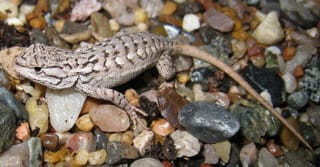 Photo: juvenile by Jennifer Macke 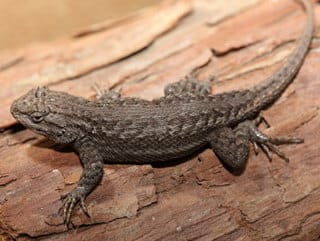 Photo: adult by Jennifer Macke |  Plateau Fence Lizard, Blue Belly Lizard(Sceloporus tristichus)Family: Phrynosomatidae (North American Spiny Lizards) Size: 3.5 - 7.5 in (9 - 19 cm) Status: native; common Habitat: sunny locations with open woodlands or prairies Typical location: Pajarito Plateau, White Rock Canyon By far the most common lizard in the area. The main body color is gray, brown, or reddish with light stripes along either side of the back. Adults may appear to be solid gray-brown with little patterning. The underside of the males has bright blue belly patches. They can be found in a wide variety of environments. They eat insects. These quick moving lizards will lose their tail when grasped by a predator, but it will eventually grow back. Tracks Info Photos Distribution Featured |
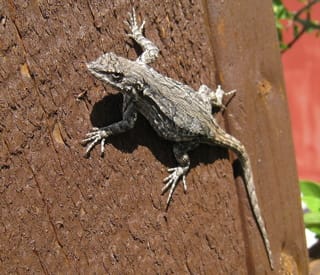 Photo: Jennifer Macke 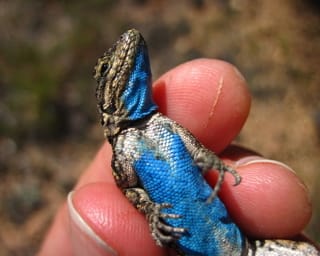 Photo: male by Robbie Deans |  Ornate Tree Lizard, Common Tree Lizard(Urosaurus ornatus)Family: Phrynosomatidae (North American Spiny Lizards) Size: 4.5 - 6.3 in (11 - 16 cm) Status: native; locally common Habitat: rocks, fence posts, and buildings in arid regions Typical location: Pajarito Plateau, White Rock Canyon At first glance, the tree lizard may look similar to the more-ubiquitous Fence Lizard. Indeed, they are similar in overall size and shape. However, the tree lizard differs in color pattern and has a more flattened body shape. The coloration of this lizard varies from population to population, probably influenced by the color of the soil. Like the Fence Lizard, the male may have blue belly patches. Despite the name, the Tree Lizard is almost always seen on rocks, not trees. Tracks Info Photos Distribution Featured |
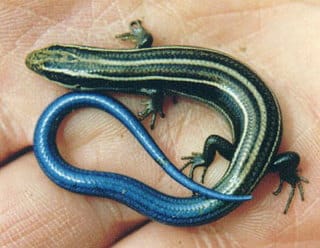 Photo: juvenile by Teralene Foxx  Photo: adult by Jerry Oldenettel |  Many-lined Skink(Plestiodon multivirgatus, Eumeces multivirgatus)Family: Scincidae (Skinks) Size: 5 - 7.6 in (13 - 19 cm) Status: native; common Habitat: areas with rocks and small brush in open grassy plains, sandy hills and desert, mountainous wooded areas; up to 8,200 ft (2,500 m) Juveniles are black with stripes and a blue tail. Adults are light brown and may or may not have stripes. Tracks Info Photos Distribution |
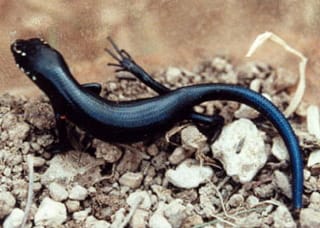 Photo: juvenile by Teralene Foxx  Photo: adult by Jennifer Macke |  Great Plains Skink, Sonoran Skink(Plestiodon obsoletus, Eumeces obsoletus)Family: Scincidae (Skinks) Size: 6.5 - 13.8 in (17 - 35 cm) Status: native; uncommon Habitat: grassy areas near permanent or semipermanent water Typical location: Frijoles Canyon, White Rock Secretive. A lizard that spends most of its time underground. Usually found near permanent water. Tracks Info Photos Distribution Featured |
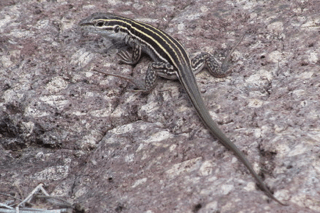 Photo: juvenile by John Karges 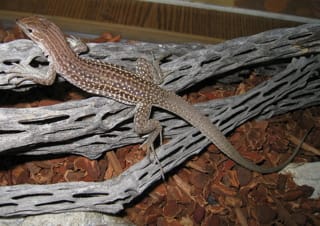 Photo: adult by Jennifer Macke |  Chihuahuan Spotted Whiptail(Aspidoscelis exsanguis, Cnemidophorus exsanguis)Family: Teiidae (Whiptails and Tegus) Size: 9.5 - 12.4 in (24 - 31 cm) Status: native; uncommon Habitat: desert, grassy areas and mountain woodlands Typical location: White Rock, White Rock Canyon This lizard is one of the less-common, but is found throughout the county. Three of our local whiptail species, including this one, are all-female (parthenogenetic) so they do not need fertilization to reproduce and lay eggs. Juveniles appear striped, with the characteristic spots becoming more obvious with age. Tracks Info Photos Distribution Featured |
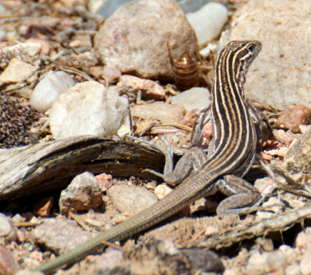 Photo: juvenile by Mitch Chapman 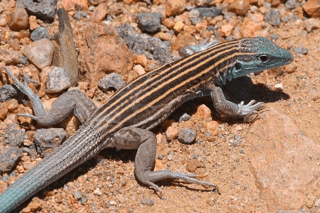 Photo: adult by J.N. Stuart |  Little Striped Whiptail, Woodland Striped Whiptail(Aspidoscelis inornatus, Cnemidophorus inornatus)Family: Teiidae (Whiptails and Tegus) Size: 6.5 - 9.4 in (17 - 24 cm) Status: native; uncommon Habitat: semiarid grasslands where vegetation is scattered Has 6 to 8 light stripes separated by dark brown to black bands without spots. The center light stripe is usually lighter and less distinct than the other stripes; this feature distinguishes it from the Plateau Striped Whiptail. Tail is bright blue, particularly in males. Throat and belly intensely blue in males and paler in females. When frightened seeks cover under brush or in burrows. Tracks Info Photos Distribution Featured |
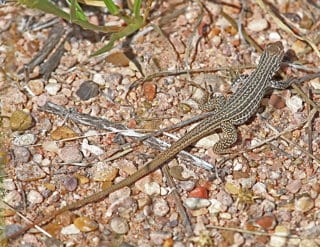 Photo: Jerry Oldenettel |  New Mexico Whiptail(Aspidoscelis neomexicanus, Cnemidophorus neomexicanus)Family: Teiidae (Whiptails and Tegus) Size: 6.5 - 9.1 in (17 - 23 cm) Status: native; uncommon Habitat: sandy arroyos and washes and other areas that periodically flood; disturbed areas with sparse vegetation Has 7 light-colored stripes down the back separated by light-spotted dark bands. Stripes are distinctly wavy or zigzagged. Tail is gray-green towards tip. Throat and belly pale blue to white. This species arose by hybridization of the Little Striped Whiptail (Aspidoscelis inornata) and the Western Whiptail (Aspidoscelis tigris). Three of our local whiptail species, including this one, are all-female (parthenogenetic) so they do not need fertilization to reproduce and lay eggs. The species is the official state reptile of New Mexico. Tracks Info Photos Distribution Featured |
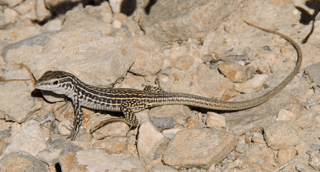 Photo: juvenile by Vicente Mata-Silva 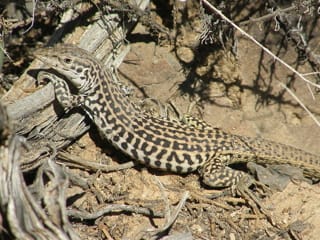 Photo: adult by Chick Keller |  Common Checkered Whiptail, Diploid Checkered Whiptail(Aspidoscelis tesselatus, Cnemidophorus tesselatus)Family: Teiidae (Whiptails and Tegus) Size: 11 - 15.5 in (28 - 39 cm) Status: native; uncommon Habitat: rocky areas on sand or gravel with grass or sparse brush Typical location: White Rock Canyon The pattern and base coloration of this lizard varies widely, with brown or black blotching, checkering or striping on a pale yellow or white base color. Tracks Info Photos Distribution Featured |
 Photo: juvenile by Gary Nafis, California Herps 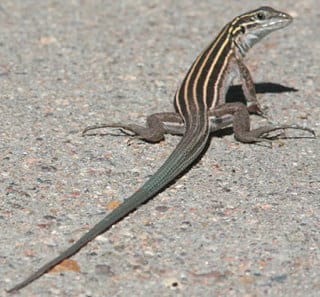 Photo: adult by Selvi Viswanathan |  Plateau Striped Whiptail(Aspidoscelis velox, Cnemidophorus velox)Family: Teiidae (Whiptails and Tegus) Size: 8 - 10.8 in (20 - 27 cm) Status: native; common Habitat: pine forests at 5,000-6,000 ft (1,600-1,800 m) Typical location: Los Alamos Plateau, White Rock, White Rock Canyon There are several similar-looking whiptails in the area, and the most common of them is the Plateau Striped Whiptail. The lizard has six distinct light-colored stripes running from head to tail. The body is black or dark brown, and the end of the tail is blue or greenish-blue (the whole tail of a juvenile is bright blue). Three of our local whiptail species, including this one, are all-female (parthenogenetic) so they do not need fertilization to reproduce and lay eggs. They seek cover under shrubs and actively pursue insects. Tracks Info Photos Distribution Featured |
